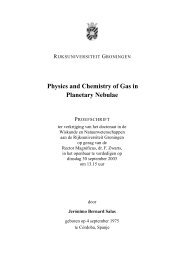TRACING ABUNDANCES IN GALAXIES WITH THE SPITZER ...
TRACING ABUNDANCES IN GALAXIES WITH THE SPITZER ...
TRACING ABUNDANCES IN GALAXIES WITH THE SPITZER ...
You also want an ePaper? Increase the reach of your titles
YUMPU automatically turns print PDFs into web optimized ePapers that Google loves.
seed nuclei relative to the β decay timescale (Iben & Renzini, 1983). While each<br />
of these stars has much less mass and evolves more slowly than a massive star,<br />
the Galaxy contains many more of these low-intermediate mass stars, and they<br />
probably produce most of the nitrogen and carbon in the interstellar medium<br />
today (Chiappini et al., 2003), making carbon mainly as a primary element and<br />
making nitrogen mainly as a secondary element during hydrogen burning (in the<br />
CNO cycle).<br />
In summary, stars with masses (∼8 M⊙–100 M⊙) which explode as core collapse<br />
SNe make most of the α-elements (like oxygen, neon, sulfur, and argon) as well as<br />
heavy r-process elements on short timescales (1–10 Myr). Low–intermediate mass<br />
stars that end their lives as Type Ia SNe produce most of the iron and limited<br />
amounts of other heavy elements on long timescales (10 Myr to 10+ Gyr). The<br />
other low–intermediate mass stars produce helium, carbon, nitrogen and heavy<br />
s-process elements, releasing their material into the interstellar medium also on<br />
long timescales. The abundance ratio of an element released in to the interstellar<br />
medium on a short timescale to that of an element released on a long timescale<br />
serves as a cosmic clock, revealing the nature of the chemical evolution of a galaxy.<br />
1.1.2 Formation and Evolution of the Galaxy<br />
Figure 1.1 shows a diagram of the different parts of the Milky Way. The Disk<br />
(including the Thin and Thick Disks) contains gas and stars. The Thin Disk<br />
contains most of the mass of the Disk and the young stars; the Thick Disk contains<br />
only a few percent of the total mass of the Disk and most of the old stars. The Bulge<br />
resides at the center of the Disk, and a spherical Outer Halo of stars surrounds<br />
the Disk and Bulge, with a spherical dark matter Halo extending out beyond the<br />
stellar Halo (Carroll & Ostlie, 1996). The Inner Halo of stars has a more squashed<br />
4













